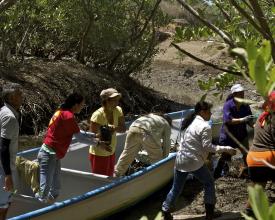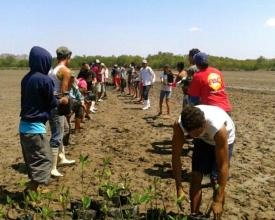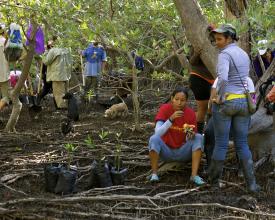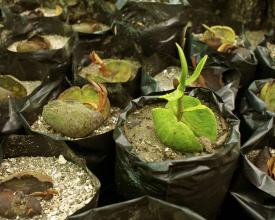Securing Livelihoods through Mangrove Conservation and Restoration
Full Solution
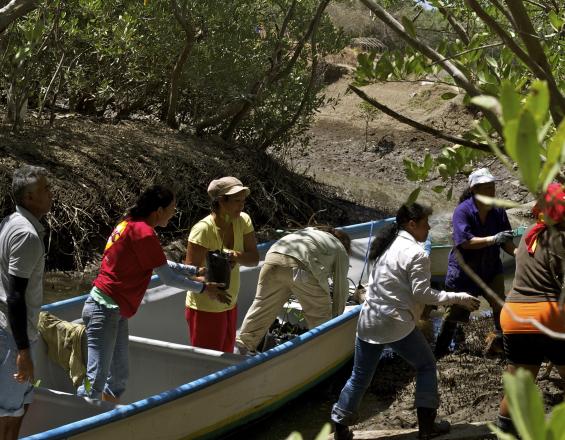
Community members move mangrove seedlings into a degraded forest, where they will plant them
©Marco Quesada / Conservation International
The ‘Securing Livelihoods’ solution addresses the root causes of mangrove loss and degradation in the Gulf of Nicoya, placing special attention on the resulting impacts on local communities. The solution involves policy making; local capacity building of micro-entrepreneurs to increase sustainable use of the mangroves and diversify community livelihoods; mangrove restoration by local stakeholders; and a local education program for schools.
Last update: 24 Sep 2025
5879 Views
Context
Challenges addressed
mangrove loss and degradation
Mangrove deforestation and degradation occurs due to excessive firewood harvest and conversion into salt evaporation and shrimp ponds. Coastal livelihoods rely heavily on fisheries that are directly linked to the health of the mangroves. Additionally, there is poor knowledge among local stakeholders and policy makers about the importance of mangrove ecosystem services.
Location
Gulf of Nicoya, Costa Rica
Central America
Process
Summary of the process
This solution has been extracted from field results obtained in 2014. In general, all components of the project were based on science and affected by the knowledge of local stakeholders and policy makers. This ‘combined knowledge’ approach favored the achievement of all project objectives. In terms of project implementation, the active engagement of local stakeholders was facilitated by an existing working and trust relation with Conservation International and the high investment of time in the field, allowing for continuous collaboration and exchange of knowledge. The latter facilitated communication of project results and lessons at various levels of local, subnational and national audiences.
Building Blocks
Science-based design
Best-available science was adapted to the local conditions in the form of research methods and field activities (i.e., approach to community-based mangrove replantation). Both scientific literature and local scientists were involved in the design and implementation of our approach. We drew from international and national scientific expertise and experience to design the areas that were to be deforested (aerial surveys, GIS mapping, satellite imaging), and the species to be replanted (depending on surveyed mangrove natural zonation).
In addition, the approach to engage local stakeholders is based on similar recorded experiences in the Philippines. In relation to the Blue Carbon estimation, we used the methods agreed upon by an international group of Blue Carbon scientists, and these methods were implemented by local scientists. The estimation was directed by a scientific expert on the subject and followed international guidelines, and a botanist was hired to direct the mangrove replantation efforts.
Enabling factors
· Existing work/trust relation with local communities
· Existing national expertise
· Local capacity
Lesson learned
In general, stakeholder engagement was conducted with a high investment in time and the development of a broad collaborative (beyond project’s objectives) relation.
The fact that the Blue Carbon estimations were made following a recognized scientific method facilitates publication, sharing and presentation of the results to international audiences and bodies such as the Intergovernmental Panel on Climate Change (IPCC) and United Nations Framework Convention on Climate Change (UNFCCC).
Active stakeholders across levels
We worked with local stakeholders at all levels of the project. Thanks to strong commitment from local women in particular, stakeholders, under guidance from an expert, took responsibility over the nursing and replantation of over 8000 mangrove plants. Local stakeholders were also engaged in capacity building for tourism microentrepreneurs, and an education program was launched at three schools. Prior clarification of the values and interests that motivate local stakeholders proved to be key in project design and implementation. Investing significant amounts of time working with and supporting the communities is critical to its success.
In general, science was integrated throughout stakeholder engagement, including the education program. Specific activities include using current knowledge to present the value of mangroves to local children; designing and implementing the replantation program; and presenting the blue carbon assessments (i.e. scientific research) to local policy makers.
Enabling factors
· Existing work/trust relation with local communities
· High investment of field time/work and results monitoring
· Local capacity
Lesson learned
The success of this approach is rooted in the strong commitment of local women in particular and fishers from the island of Chira, in the Gulf of Nicoya. We invested significant amounts of time in the communities, working with them and supporting their work, instead of having them support “our” project. Prior clarification of the values and interests that motivate local stakeholders proved to be key in project design and implementation. We believe a field project has to understand and consider the interests and values of local stakeholders and include them into the activities that are being planned in order to achieve concrete, meaningful and durable results.
Informing policy processes
At the national level, the results from the Blue Carbon component, such as carbon budget for the mangroves of the gulf of Nicoya and an updated deforestation estimation, were presented to decision makers as a way to inform policy making on broader climate change mitigation strategies that target multiple ecosystem services.
Enabling factors
To be provided by solution provider.
Lesson learned
To be provided by solution provider.
Impacts
Mangrove replantation in this project had a survival success of over 90%. Science based design and community engagement proved key in achieving this result, including a complete baseline measurement of carbon sequestration for the mangroves of Nicoya, an education program for school children and an assessment of the total existing area of mangroves for the gulf. Costa Rica protects by law all mangroves in the country since the late 1970s. This is a factor that has reduced, but not stopped, mangrove ecosystem degradation.
Local stakeholders took responsibility over the nursing and replanting of +8000 mangrove plants in degraded mangrove areas near their communities. More than 260 children were involved in monthly classes on mangrove and marine biology. Two successful mangrove nurseries were established and operated by local stakeholders.
Beneficiaries
artisanal fishers, coastal communities, and national policy makers
Story
Mangroves in the Gulf of Nicoya, a highly productive estuarine system in Costa Rica’s Pacific coast, came under increasing pressure in the 1950s and 60s, when they were stripped for firewood and converted to salt evaporation and shrimp ponds. While these pressures have yet to claim significant areas of Costa Rica’s mangroves, degradation of these ecosystems can be costly at local and national scales. The expansion of shrimp and salt ponds, as well as the expansion of agriculture, remain as threats in Costa Rica.
Mangroves provide multiple benefits both locally for the coastal communities in Nicoya, who rely on fisheries that are directly linked to the health of the mangroves, as well as globally. Mangrove trees’ complex roots slow water flow, which allows sediment to build up and store huge amounts of carbon (often called blue carbon), more than terrestrial forests do.
When we decided to start a pilot project on mangrove reforestation, a group of women from the island of Chira were the first to say yes. For five months a group of 23 women cleaned a mangrove area near their community of entangled nets and plastic. Next they began planting mangrove seeds in bags that they filled by hand with sand and sediment, watering these plants twice a day.
The women did all this work on a voluntary basis while still taking care of their daily family duties. In Chira, women play a heavy role in raising children, looking after the house and searching for other sources of income. Their husbands, mostly small-scale fishers, rely on mangroves for fish, who live within these mangroves when young and depend on them for food when adults.
On an island where opportunities for work are few, the women recognized the project’s potential to attract tourists and even the attention of government agencies that could eventually pay for their time and energy. A year after they started, they had replanted over 8,000 mangrove plants in degraded areas with a survival rate over 90%. Other communities on the island were inspired and started their own replantation projects. They have been visited by the heads of government agencies and even tourists. Policy makers also have witnessed the dependence of coastal communities on mangrove forests, and are now aware of the huge carbon sink that the sediments of mangrove areas represent. In a time when climate change and overfishing seem to be ubiquitous, mangroves provide hope to those who depend on them directly and indirectly.
Connect with contributors
Other contributors
Marco Quesada
Conservation International
Ana Gloria Guzmán
Conservation International
